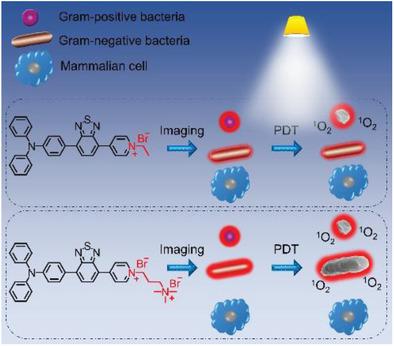当前位置:
X-MOL 学术
›
Small Methods
›
论文详情
Our official English website, www.x-mol.net, welcomes your feedback! (Note: you will need to create a separate account there.)
Killing G(+) or G(−) Bacteria? The Important Role of Molecular Charge in AIE‐Active Photosensitizers
Small Methods ( IF 12.4 ) Pub Date : 2020-04-06 , DOI: 10.1002/smtd.202000046 Xiujuan Shi 1, 2 , Simon H. P. Sung 1, 2 , Joe H. C. Chau 1 , Ying Li 2, 3 , Zhiyang Liu 1 , Ryan T. K. Kwok 1, 2 , Junkai Liu 1 , Peihong Xiao 3 , Jiangjiang Zhang 4 , Bin Liu 5 , Jacky W. Y. Lam 1, 2 , Ben Zhong Tang 1, 2, 3, 6
Small Methods ( IF 12.4 ) Pub Date : 2020-04-06 , DOI: 10.1002/smtd.202000046 Xiujuan Shi 1, 2 , Simon H. P. Sung 1, 2 , Joe H. C. Chau 1 , Ying Li 2, 3 , Zhiyang Liu 1 , Ryan T. K. Kwok 1, 2 , Junkai Liu 1 , Peihong Xiao 3 , Jiangjiang Zhang 4 , Bin Liu 5 , Jacky W. Y. Lam 1, 2 , Ben Zhong Tang 1, 2, 3, 6
Affiliation

|
Bacterial infections pose a serious threat to human health. Photodynamic therapy is an effective medical treatment to solve the problems raised by antibiotic resistant bacteria. But it is not easy to have photosensitizers (PSs) that can simultaneously produce efficient fluorescence and reactive oxygen species. Traditional PSs show compromised performances due to the aggregation‐caused quenching effect in aqueous media, however, luminogens with aggregation‐induced emission (AIE) can inherently achieve high fluorescence and efficient ROS generation. In addition, electrostatic interaction is generally accepted to be responsible for initial targeting of bacteria. But for AIE PSs, the roles of molecular charges on antibacterial efficiency are rarely considered. Herein, two red‐emissive AIE PSs with the same luminogenic core but carrying different number of positive charges are designed, and their antibacterial performance and the killing mechanism toward Gram‐positive (G(+)) and Gram‐negative (G(−)) bacteria are investigated. The AIE PSs with highly efficient singlet oxygen generation can clearly image and selectively kill bacteria over mammalian cells. With the increase in the positive charges of AIE PSs, the improvement in antibacterial efficiency is great against G(−) bacteria, but it is negligible against G(+) bacteria. This research will provide new insight into the rational design of new antibacterial materials.
中文翻译:

杀死G(+)或G(-)细菌?分子电荷在AIE活性光敏剂中的重要作用
细菌感染严重威胁人类健康。光动力疗法是解决抗生素抗性细菌引起的问题的有效药物。但是拥有同时产生有效荧光和活性氧的光敏剂(PSs)并不容易。传统的PS由于在水性介质中由于聚集引起的猝灭作用而表现出较弱的性能,但是具有聚集诱导发射(AIE)的发光剂可以固有地实现高荧光和有效的ROS生成。另外,通常认为静电相互作用负责细菌的初始靶向。但是对于AIE PS,很少考虑分子电荷对抗菌效率的作用。在这里 设计了两种具有相同发光核心但带有不同数量正电荷的红色AIE PS,它们的抗菌性能以及对革兰氏阳性(G(+))和革兰氏阴性(G(-))细菌的杀灭机制被调查。具有高效单线态氧生成的AIE PS可以清晰地成像并选择性杀死哺乳动物细胞上的细菌。随着AIE PSs的正电荷的增加,对G(-)细菌的抗菌效率提高很大,但对G(+)细菌却微不足道。这项研究将为新型抗菌材料的合理设计提供新的见解。具有高效单线态氧生成的AIE PS可以清晰地成像并选择性杀死哺乳动物细胞上的细菌。随着AIE PSs的正电荷的增加,对G(-)细菌的抗菌效率提高很大,但对G(+)细菌却微不足道。这项研究将为新型抗菌材料的合理设计提供新的见解。具有高效单线态氧生成的AIE PS可以清晰地成像并选择性杀死哺乳动物细胞上的细菌。随着AIE PSs的正电荷的增加,对G(-)细菌的抗菌效率提高很大,但对G(+)细菌却微不足道。这项研究将为新型抗菌材料的合理设计提供新的见解。
更新日期:2020-04-06
中文翻译:

杀死G(+)或G(-)细菌?分子电荷在AIE活性光敏剂中的重要作用
细菌感染严重威胁人类健康。光动力疗法是解决抗生素抗性细菌引起的问题的有效药物。但是拥有同时产生有效荧光和活性氧的光敏剂(PSs)并不容易。传统的PS由于在水性介质中由于聚集引起的猝灭作用而表现出较弱的性能,但是具有聚集诱导发射(AIE)的发光剂可以固有地实现高荧光和有效的ROS生成。另外,通常认为静电相互作用负责细菌的初始靶向。但是对于AIE PS,很少考虑分子电荷对抗菌效率的作用。在这里 设计了两种具有相同发光核心但带有不同数量正电荷的红色AIE PS,它们的抗菌性能以及对革兰氏阳性(G(+))和革兰氏阴性(G(-))细菌的杀灭机制被调查。具有高效单线态氧生成的AIE PS可以清晰地成像并选择性杀死哺乳动物细胞上的细菌。随着AIE PSs的正电荷的增加,对G(-)细菌的抗菌效率提高很大,但对G(+)细菌却微不足道。这项研究将为新型抗菌材料的合理设计提供新的见解。具有高效单线态氧生成的AIE PS可以清晰地成像并选择性杀死哺乳动物细胞上的细菌。随着AIE PSs的正电荷的增加,对G(-)细菌的抗菌效率提高很大,但对G(+)细菌却微不足道。这项研究将为新型抗菌材料的合理设计提供新的见解。具有高效单线态氧生成的AIE PS可以清晰地成像并选择性杀死哺乳动物细胞上的细菌。随着AIE PSs的正电荷的增加,对G(-)细菌的抗菌效率提高很大,但对G(+)细菌却微不足道。这项研究将为新型抗菌材料的合理设计提供新的见解。



























 京公网安备 11010802027423号
京公网安备 11010802027423号